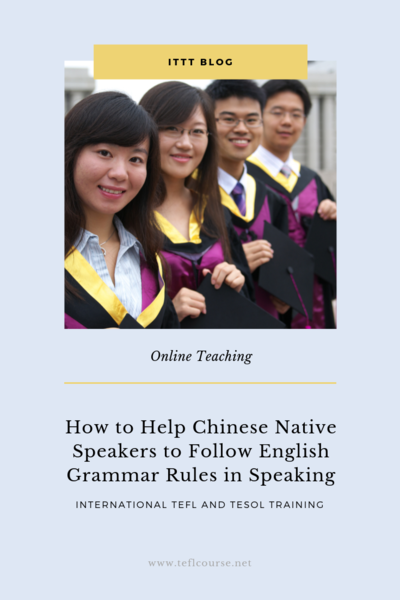How to Help Chinese Native Speakers to Follow English Grammar Rules in Speaking

Grammar is the rules governing the composition of clauses, phrases, and words in a natural language. Simply put, grammar is the general rule of a language. Language is logical; grammar tells us in which order we say words. It's about how words become phrases; how words and phrases become sentences and how sentences become language.
Table of Contents
Different languages have different grammar rules
How to teach grammar (EFL: how to teach Chinese students English)
Do you want to teach English abroad? Take a TEFL course!
This post was written by our TEFL certification graduate Yang S. Please note that this blog post might not necessarily represent the beliefs or opinions of ITTT.
The Essence of Grammar
Some of these rules are acquired naturally in childhood while others are acquired in the learning process under the guidance of a teacher. While most of the time, people don't know which grammatical rule they are following when speaking, they know that what they say is grammatically accurate. They simultaneously process the language and accurately produce it either orally or in written form. This begs the question, do we consciously analyze language when speaking? The answer is no. We do however subconsciously analyze it, but we don't realize this process is taking place because the time it takes is too short to perceive. As a result, native speakers can accurately produce grammar despite not knowing why they use that specific rule.

Also Read: 7 Important Questions about Business English
Different languages have different grammar rules
Although all languages have grammar, grammatical rules can vary dramatically between them. We can say the grammar of two different languages is similar. We cannot, however, say they are identical. Some have similar grammar because languages can be grouped into families. For example, Spanish and Portuguese are both members of the Indo-European languages. As languages are fluid though, each has its unique history. Regarding languages in different families, the differences can be significant. For instance, in English sentence order is subject, verb then object. But in Japanese the order is subject, object then verb. Various cultural factors combine to form language. We can, therefore, say that grammar develops according to the mindset of its speakers.
Also Read: Should I take a TEFL course online or in a classroom?
How to teach grammar (EFL: how to teach Chinese students English)
As Chinese students, we begin learning English in primary school (around 7 years old). The learning process is characterized by remembering vocabulary and repeating sentences and phrases. It is a very rigid method of learning. Students, therefore, develop a habit of mentally translating Chinese into English, instead of analyzing meaning in Chinese and producing the same meaning using native-English language. For example, the Chinese word for "subway" is " Die". Translated directly into English, this means "iron road". This, of course, would confuse a native English speaker.
This phenomenon is a combination of Chinese and English, hence the name "Chinglish". The cause of this is a misunderstanding of English grammar rules. So what is best practice for teaching Chinese students? First of all, it depends on the students' English level and age. Some adult students already have a solid foundation in English. For those learners, teaching grammar in English is best practice because this forces them to analyze the intricacies of the rules. Children under 13, however, require a different approach. At this age, the students' brains are still developing, which means they can acquire different methods at a faster pace than older students. Despite this, younger students require language which is easier to understand. This may even involve the use of body language and gestures to clarify meaning.

Also Read: How to Deal With the Classroom Discipline
Low-level adult students require an explanation in their native language because they have not yet reached the required level for comprehension of grammatical terminology. In such cases, we need to emphasize the differences between these two languages and to discourage bad study habits developing early on in the learning process. A fully-developed adult mind will look at the form of a sentence and attempt to analyze it in their native language. For instance "I get up early every day, but today I got up late". An adult student will often confuse the present and past tense form of verbs as Chinese does not change the form of the verb in different tenses. A child, however, can listen to the second language with ease and will not analyze the grammar. Put simply, a young learner will copy.
Do you want to teach English abroad? Take a TEFL course!
Grammar is the structure of a language. You may remember lots of vocabulary, but if you don't know how to use it with grammar, it is very difficult to communicate effectively. Various factors must be considered when teaching grammar, for example, age and English level. Teachers must remember their students' needs.
Apply now & get certified to teach english abroad!
Speak with an ITTT advisor today to put together your personal plan for teaching English abroad.
Send us an email or call us toll-free at 1-800-490-0531 to speak with an ITTT advisor today.
Related Articles:
- Step-By-Step Guide to Legally Teaching English in China
- 10 Questions You Need to Ask Before Enrolling In a TEFL Course
- The 10 Best Destinations for Teaching English Abroad in 2018
- Online or In-Class - Which TEFL Course Should You Take?
- The Best Government Programs For Teaching English Abroad
- What Scams to Look Out for When Looking for TEFL Jobs




